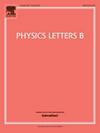用GDR γ衰变探测72Kr复合核中的同位旋混合
IF 4.5
2区 物理与天体物理
Q1 ASTRONOMY & ASTROPHYSICS
引用次数: 0
摘要
利用巨偶极子共振的γ衰变,在1.3 MeV左右的低温下,推导出了复合核72Kr的同位旋混合。测量了两种复合核反应的γ射线:来自轰击能为90 MeV(同位旋I = 0)的32 S + 40Ca,以及作为参考的82 MeV(同位旋I = 0)的31 P + 40Ca。在布加勒斯特串联实验室使用了ELIGANT阵列,由康普顿抑制闪烁体探测器组成。测量光谱的统计模型分析提供了(3.5±0.8)%的混合参数。这个蓝色的新点,与其他几个已有的点相比处于最低的温度,可以验证同位旋混合的温度依赖性的预测。从目前的同位旋混合结果中提取了用于费米超允许跃迁的同位旋对称性破缺校正δc,发现它与β衰变数据、理论预测和先前的实验结果一致。本文章由计算机程序翻译,如有差异,请以英文原文为准。
Probing the isospin mixing in the 72Kr compound nucleus via GDR γ decay
The isospin mixing was deduced in the compound nucleus 72Kr at a low nuclear temperature around 1.3 MeV, from the γ decay of the giant dipole resonance. The γ rays from two compound-nucleus reactions were measured: from the 32 S + 40Ca at bombarding energy of 90 MeV characterized by isospin I = 0, and from the 31 P + 40Ca at 82 MeV used as a reference. The ELIFANT array was employed at the Bucharest Tandem Laboratory, consisting of Compton-suppressed scintillator detectors. The statistical-model analysis of the measured spectra provided a mixing parameter of . This new point, being at the lowest temperature compared with the few other existing ones, can validate the predictions of the temperature dependence of the isospin mixing. The isospin-symmetry-breaking correction, , used for the Fermi super-allowed transitions was extracted from the present result of the isospin mixing and found to be consistent with β decay data, theoretical predictions, and previous experimental results.
求助全文
通过发布文献求助,成功后即可免费获取论文全文。
去求助
来源期刊

Physics Letters B
物理-物理:综合
CiteScore
9.10
自引率
6.80%
发文量
647
审稿时长
3 months
期刊介绍:
Physics Letters B ensures the rapid publication of important new results in particle physics, nuclear physics and cosmology. Specialized editors are responsible for contributions in experimental nuclear physics, theoretical nuclear physics, experimental high-energy physics, theoretical high-energy physics, and astrophysics.
 求助内容:
求助内容: 应助结果提醒方式:
应助结果提醒方式:


